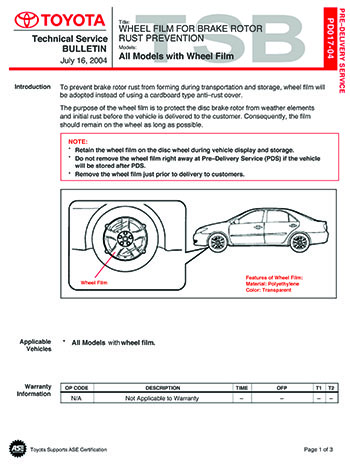 You are getting ready to perform a brake job on a vehicle. While checking the torque specifications on the vehicle, you decide to hit the tab with TSBs and recalls. All of a sudden you are staring at a screen of brake recall notices and TSBs for that make, model and year of vehicle.
You are getting ready to perform a brake job on a vehicle. While checking the torque specifications on the vehicle, you decide to hit the tab with TSBs and recalls. All of a sudden you are staring at a screen of brake recall notices and TSBs for that make, model and year of vehicle.
What should you do? First, relax. Most of the recalls apply to a very small number of that make and model. Most of the recalls focus in on a defect that happened on the assembly line and was caught when the vehicle was new or was in the dealer’s inventory.
These recalls can range from an incorrect torque setting on a caliper bracket to an updated piece of software for the ABS computer. These defects may only cover a very limited range. You can usually ignore these recalls that focus on less than 10,000 vehicles, even if these are the recalls that get the most attention in the press.
Why do brake defects get recalled before defects with engines, transmissions and electrical systems? The short answer is that a brake defect is the most dangerous problem of all. NHTSA doesn’t care if your car stalls, burns oil or the manufacturer is not abiding by the warranty. But NHTSA will fast-track any investigation if the defect poses immanent and potential death to vehicle occupants. Safety is the main priority. No OEM or government agency wants to be seen dragging their feet when people’s lives are at stake.
For example, the recent GM recall for the parking brake problem has produced zero fatalities and no major crashes, according to NHTSA’s ODI database. According to both GM and NHTSA, only 100 cars are estimated to have the defect, but it was dramatic because the parking brake catches fire.
The consumer complaints had all the hallmarks of a great recall and civil/criminal lawsuits. This got an investigator at NHTSA asking GM questions. GM asked its dealers and engineers to look out for the problem. In just six months, after about three reported fires and six crashes, GM and the government solved the problem and a recall was issued.
As another example, when assembling this year’s Chevy Malibu and Buick Lacrosse mild hybrid models, somebody down the line somehow put rear rotors on the front of 8,208 cars. NHTSA reported 1,900 of the affected models are actually in consumers’ hands. If you do the math on the rotor mix up, you realize that you have a better chance of seeing Bigfoot than one of these cars in your bay.
Filtering the Information
The key to using TSBs and recalls is to sort them by date with the newest at the top. Typically, the oldest information has the least amount of relevance to the vehicle because these were written when the vehicle was having teething problems.
The latest TSBs and recalls have the most relevance to the technician at an independent shop. These are sometimes based on problems seen in the field and can be valuable in resolving problems.
An example of this was a recent TSB about an issue with some 2011-‘12 Mini models. The TSB was titled “Erroneous ‘Service Due’ message for Brake Pad Thickness.”
The models in question display a message about brake pad thickness and that the pads should be serviced soon. When the pads are checked, they are above specifications for replacement.
For the Mini, the thickness of the pads is a computer estimate. The mathematical calculations are made by the condition based services module (CBS). The CBS uses inputs like vehicle speed, pedal pressure and rotor temperature to determine pad thickness.
The solution is to re-flash/reprogram the CBS module with new software and a better algorithm to estimate pad wear.
Another example is the Dodge Sprinter TSB 08-028-06. In this TSB, Chrysler explains how a burned out or incorrect type brake light bulb could result in unrelated DTCs in the ECM or ABS/ESP control module. The TSM also tells technicians to look for corrosion in the trailer tow connector, as well as on a tail light circuit board.
The TSB walks technicians through preliminary checks to diagnose the condition, and to check for the correct P21/5W or 12V 21/5W bulbs. This is diagnostic gold for any technician.
These TSBs were issued for vehicles that were three years old and probably out of warranty, and they illustrate how a TSB can help a technician solve a problem long after the vehicle has left the factory.
Superseded Bulletins
You may also run across “superseded” bulletins, which are updated bulletins that the OEM thinks still has relevance to the vehicle or a violated warranty policy. These can be updated procedures or amendments to the service manual. These can be hit or miss. Some bulletins may concern pre-delivery inspection issues like rotor lot rot or how to install a floor mat so it doesn’t interfere with the brake pedal.
Should you check for TSBs every brake job? No. But if you see abnormal brake wear, an unusual noise complaint or just a vehicle you have never worked on before, looking at the brake-related TSBs and recalls may save you time.













